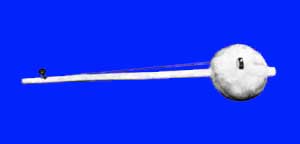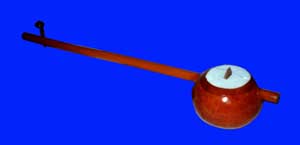
|
Ektar is a simple folk instrument. It is used to provide both a
drone as well as simple rhytmic accompaniment to folk songs. It may
be the oldest stringed instrument in the Indian subcontinent. The ektar is described in ancient Sanskrit texts as the ekatantri vina,
literally the "one stringed lute". In Punjab the ektar is known as
the tumbi Indian subcontinent. The ektar is described in ancient Sanskrit texts as the ekatantri vina,
literally the "one stringed lute". In Punjab the ektar is known as
the tumbiThe construction is very simple, it is nothing more than a gourd which has been penetrated by a stick of bamboo. Another piece of bamboo forms the tuning peg. The bridge is merely a coin, piece of coconut, plastic or similar object. Ektars such as this are common in the south. In the north, their construction is a little more complicated. A membrane is stretched over the gourd and the bridge is placed over the taut membrane. The term ektar literally means "one string", as such the term is loosely applied to a variety of one-stringed folk instruments. This includes such instruments as the tuntun, katho, anand lahari, and gopichand. The ektar is very popular in folk music and has a strong rustic connotation. It is very much associated with the saint Mira Bai. The smaller Punjabi version (tumbi) is much associated with the bhangra style of song and dance. Among the Gadaba and Paraja tribes of Orissa, it is known as dudumah and dung-dungi.  |
||